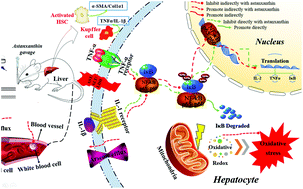Inflammation response after the cessation of chronic arsenic exposure and post-treatment of natural astaxanthin in liver: potential role of cytokine-mediated cell–cell interactions
Abstract
Ongoing groundwater arsenic contamination throughout China was first recognized in the 1960s. Groundwater arsenic contamination is a high risk for human and animal health worldwide. Apart from drinking water, diet is the second pathway for arsenic to enter the human body and eventually cause liver injury. Natural astaxanthin extracted from the green algae Haematococcus pluvialis has dominated the nutraceutical market for potential health benefits. Nevertheless, the molecular mechanism underlying the protective effect post astaxanthin against arsenic-induced hepatotoxicity remains largely obscure. In this study, we investigate the effect of natural astaxanthin (derived from Haemotococcus pluvialis) on oxidative stress and liver inflammatory response in rats after the cessation of chronic arsenic exposure. Wistar rats were given astaxanthin (250 mg kg−1) daily for 2 weeks after the cessation of exposure to sodium arsenite (300 μg L−1, drinking water, 24 weeks) by intragastric administration. The results showed that post treatment with astaxanthin attenuated liver injury induced by long-term exposure to arsenic in rats. Most importantly, post treatment with astaxanthin decreased the increasing of inflammatory cytokine NF-κB, tumor necrosis factor-α, interleukin-1β, oxidative stress level, and total arsenic content in livers of rats exposed to arsenic. In addition, post treatment with astaxanthin reversed the increasing of protein levels of alpha-smooth muscle actin and collagen Iα1, which are the activation markers of hepatic stellate cells (HSCs). Collectively, these data demonstrate that post astaxanthin treatment attenuates inflammation response in the liver after the cessation of chronic arsenic exposure via inhibition of cytokine-mediated cell–cell interactions. Daily ingestion of natural astaxanthin might be a potential and beneficial candidate for the treatment of liver damage after the cessation of chronic exposure to sodium arsenite.



 Please wait while we load your content...
Please wait while we load your content...